What is Single-Origin Coffee?
Have you ever entered a café, looked at some of the menu items, and questioned why coffee was referred to as “single origin”? What does that term mean, what is its relevance, and why should it matter to you as a consumer?
This guide will discuss single origin in the context of coffee menus, coffee labels, and what the differences are in single-origin coffees from around the world.

Table of Contents
Single Origin Basics
Single Farm, Single Estate, Single Origin
“Single origin” refers to coffee originating from one region, crop, or producer within a country. “Single estate” and “single farm” coffee originates from a single co-operative, mill, or farm. When you look at “single estate coffee” labels, you will notice the listing of the padlock, lot, estate, or micro-lot the coffee was grown on.
A crucial aspect of designating a coffee “single origin” is its traceability – i.e., where it came from and its particular type (as opposed to blend). When coffee can be traced back to a farm, the source of its distinctive flavor can be identified – through the acidity of the soil and its growing environment.
Single Origin’s Growth in Popularity
How did the term “single origin” become part of our lexicon? Interest in single origin coffee stemmed from specialty cafés, often using alternative brewing techniques, like the AeroPress and pour overs, that sought to highlight specific tasting notes in coffee that were most pronounced in coffee exclusively from one area- a “single origin”. Single Origin also became preferred as a method for allowing transparency and traceability in coffee, allowing aficionados to know with confidence exactly how and where the coffee they are drinking was cultivated.
Single Origin Coffee Drives Quality Improvement
The rising popularity of single origin coffee has significantly impacted coffee production as consumer choices have a significant impact on farming practices. In general, farmers enhance the quality of their crops in response to consumer demands.
With single-origin coffee’s rapid expansion in popularity, many coffee producers have begun experimenting with an assortment of cultivars or varieties, controlling growing periods, varying harvesting methods, varying duration, and refined their processing and milling techniques in order to respond to increased consumer interest in specialty coffee.
These experiments, and the resulting better quality coffee, would not have been possible without direct trade between farmers and roasters. Producers rely on roasters for updates about market trends while specialty roasters regularly seek innovative single origin coffee to promote to consumers. Additionally, roasters gain insights from the producers about their coffee that can be used for quality enhancement.
In furtherance of improving coffee quality, many roasters go on sourcing trips to visit coffee producers. Sourcing trips help to keep green bean farmers and rosters on the same page, giving first-hand insights into the effects of processing and farming on the beans. Roasters, buyers, and growers drink cups alongside each other, occasionally sampling as many as 100 coffees daily. These sourcing trips also help to profile and score coffee, allowing for additional data to provide to the consumer.
How is the Quality of Single Origin Coffee Assessed by the Industry?
Industry assessment platforms have been developed to assess the quality of single-origin coffees. Coffee Review, Coffee Quality Institute, and Cup of Excellence are the three most prominent. While these platforms are not intended to steer consumers towards particular varieties of coffee, roasters and producers do use ratings for marketing purposes.
Coffee Review is invaluable for retailers and roasters alike. Perhaps the most influential and well-read coffee buyer’s guide in the world, it offers roast profile reviews. The Coffee Quality Institute’s Q system follows Specialty Coffee Association of American’s (SCAA) protocols to determine which varieties should be classified as fine Robusta, fine Arabica, and blends. The industry’s top-tier accreditation is the Cup of Excellence, which judges the production and quality of rare, specialty lots.
These organizations strive to measure the quality of coffee, free of bias. Often, a 100-point review system and blind cupping are used for this purpose, and descriptive classifications are used by coffee professionals for scoresheet tasting.

(Credit Simon Wright, https://www.flickr.com/photos/diversionary/16139995733, CC 2.0)
Thoughts on term “Single Origin” as used by Coffee Roasters
Today, the sky’s the limit for single origin coffee production – with day lots, single farm lots, and single variant lots. Yet, from its inception, “single origin” didn’t refer to coffee that was of a higher quality, but rather categorized a roaster’s house blend.
Is “single origin” a misnomer, then?
To answer this question, let’s consider a country like Tanzania, which has tropical coastal weather, the Nyiri desert, the Serengeti, Lake Victoria, and the snow-covered peak of Mount Kilimanjaro. The geography of these different areas all within the same region is incredibly varied, producing different combinations of flavors. Using the term “single origin” to describe this area risks misrepresenting the distinctiveness of the different coffees coming from this region.
Nonetheless, particular regions do have particular coffee notes endemic to them and common profiles that can serve as a rough generalization for the flavor of the coffee. While the geography of Tanzania is incredibly varied, notes of black currant with a chocolate finish are common amongst these diverse regions.
I encourage you to explore the undiscovered world of quality coffee by starting your adventure off with a cup of single origin coffee today.
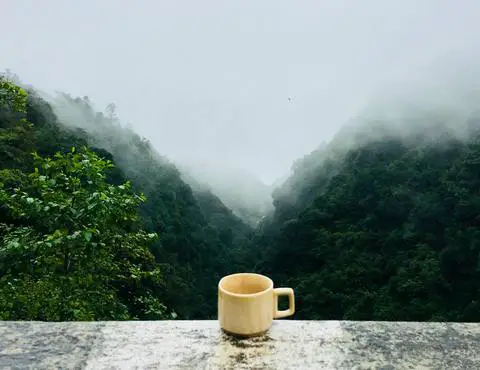
Comparisons of Single Origin Coffees
One of the most exciting things about trying single origin coffee is having the chance to experience unique flavor notes in their most prominent forms. In most blends, tons of flavor notes mix together, making it hard to appreciate any one note. In contrast, single origin coffees allow for focusing on specific flavors in coffee. Our chart below notes some common flavors found in single origin coffees from countries around the world:
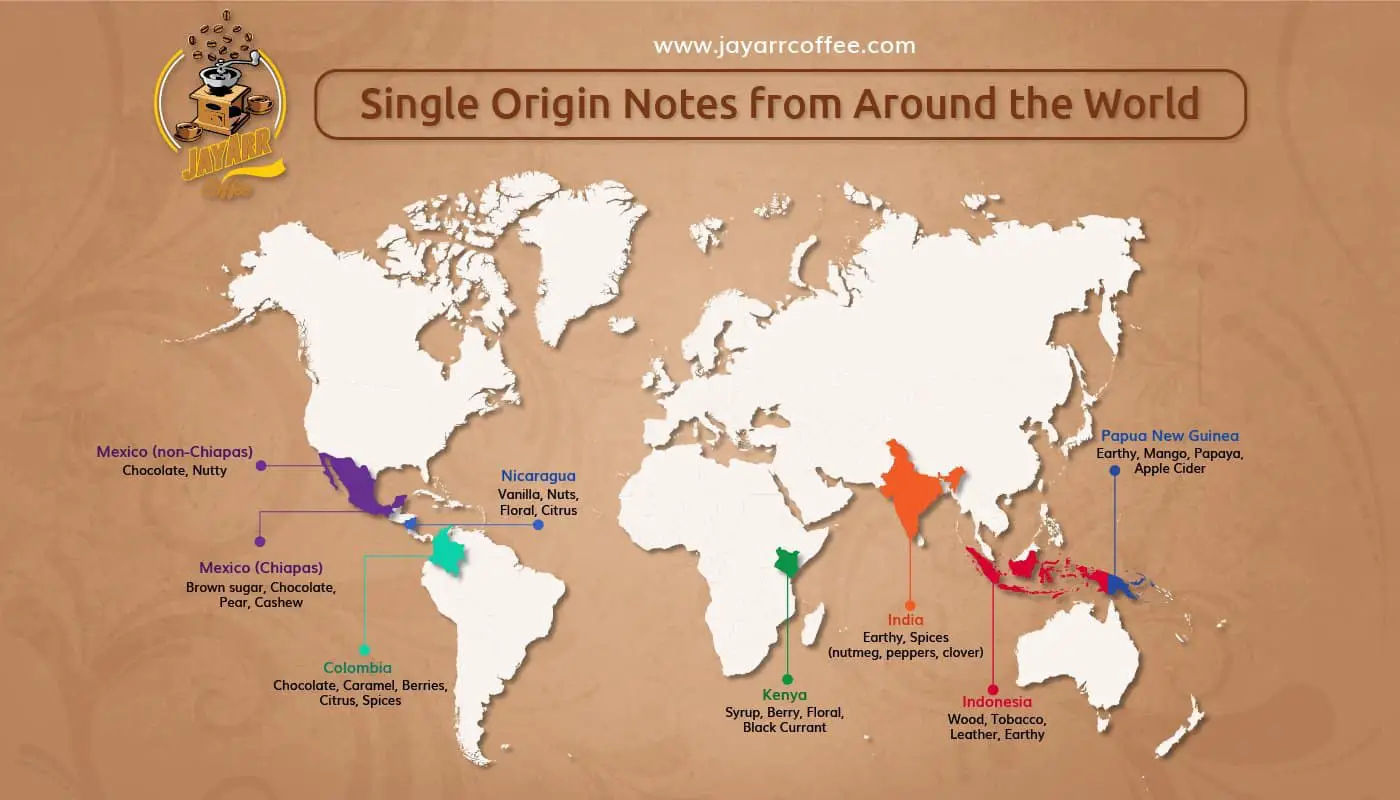
In terms of acidity, single origin Colombian, Indonesian, Indian, and Nicaraguan coffees are usually a safe bet for those looking for reduced acidity. Kenyan single origin is an excellent choice for those looking for a pronounced acidic flavor:
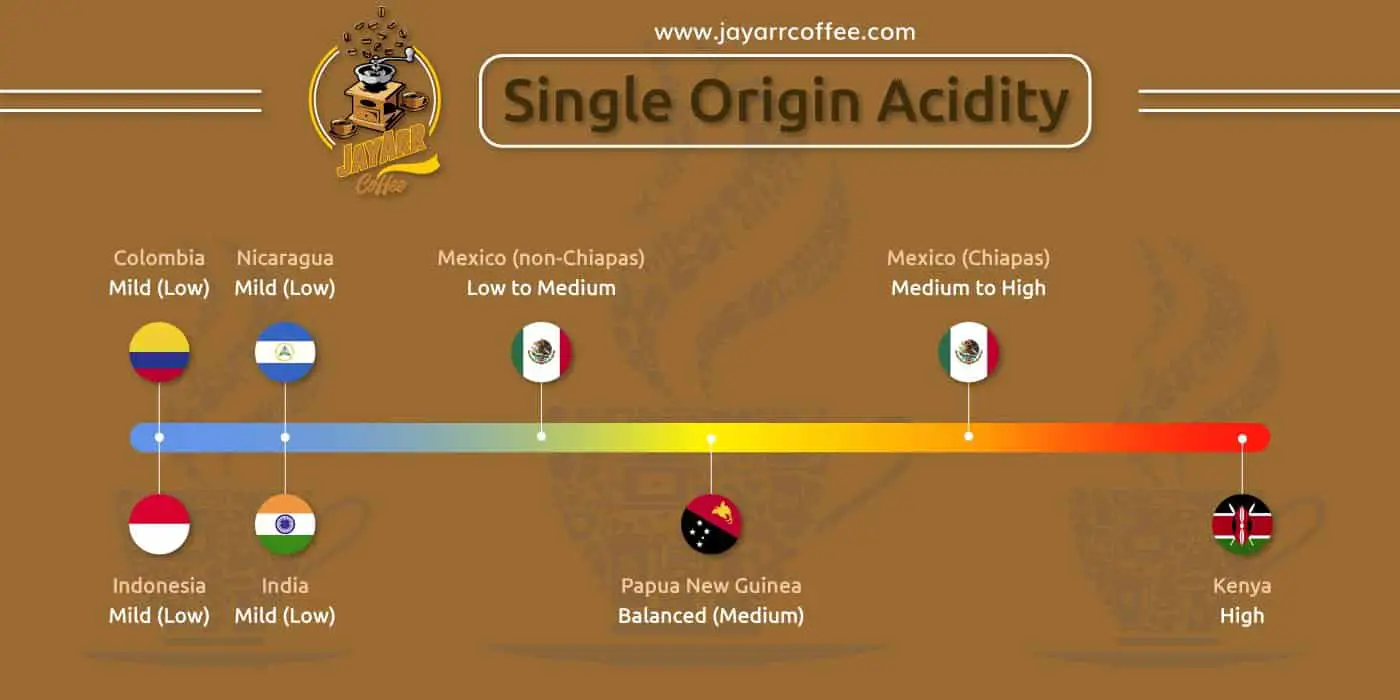
Mexican coffee not from the Chiapas region tends to have the lightest body. For a heavier, full bodied coffee, single origin coffees from India, Indonesia, Papua New Guinea, and Kenya are all great choices.

Mexican Single Origin Coffee
Mexican origin coffee is renowned for its nutty tangs, highlighted by chocolaty overtones. With its light-body, medium acidity, and a palatable dryness, Mexican coffees often strike the palette much like a white wine. Overall, Mexican single origin coffee delivers one of the most inclusive flavor profiles associated with gourmet coffee, with different tasting profiles that depend on where in Mexico the coffee is produced- more on this shortly!
History of the Mexican Origin Coffee
Coffee plants have been grown in Veracruz, Mexico, since the late 18th century, with production hitting its peak in 1954. In the late 1900s, coffee production in Mexico spread across 12 states, and Chiapas was the biggest coffee-producing city in the region. By 1982, over 400,000 hectares of the Mexican landmass had been used for the production of coffee, employing over 2 million Mexicans.
There are a plethora of Mexican single-origin coffees from which to choose. However, the “Altura” graded Mexican origin coffee is considered the highest quality coffee produced in the area. Altura graded coffees are generally grown in the highlands of Mexico. Altura coffee beans of the Mexican origin are very highly rated in the Americas and are renowned for their mild, slightly sweet flavor.
Tasting Notes of Mexican Origin Coffee
With regards to the tasting notes of Coffee grown in Mexico, there is extensive variation due to how much production comes from smaller scale growers with different practices and varieties of arabica grown. Numerous regions in Mexico grow superb quality beans. The three principal areas where the Mexican origin coffee is sourced are Chiapas, Veracruz, and Oaxaca.
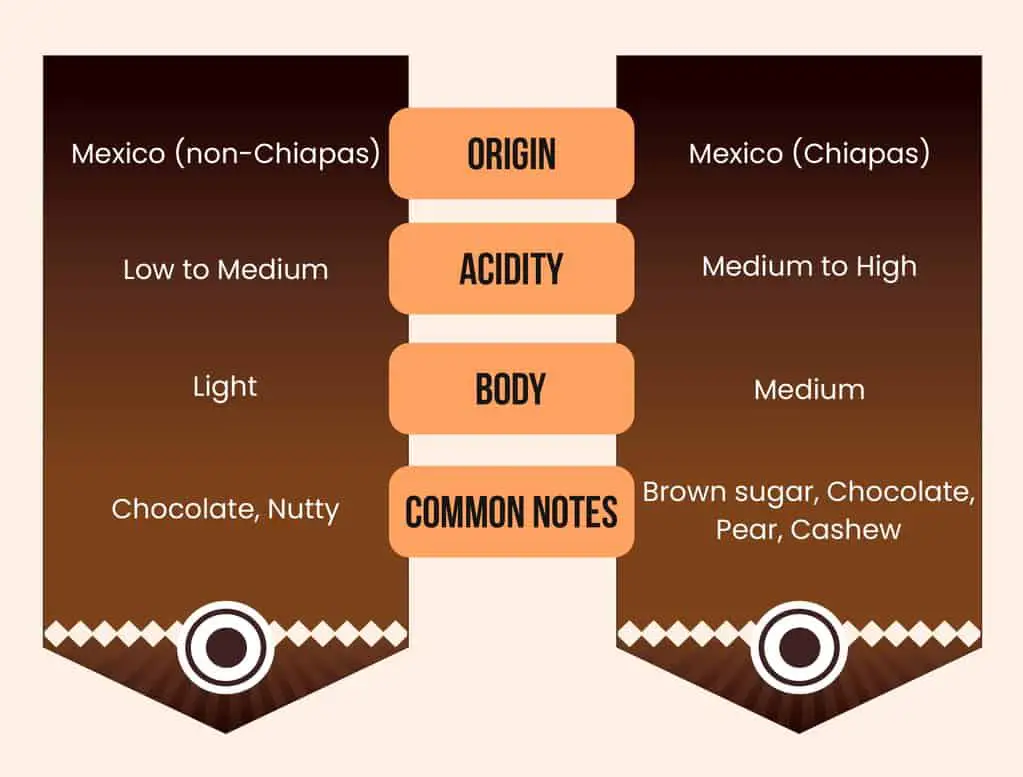
However, if we were to generalize about the flavor profile of Mexican origin coffee distinct nutty tangs and chocolatey overtones hinted with mild caramel undertones are shared amongst many Mexican varieties. These sweet rich flavors are usually accompanied by light to medium acidity with a subtle white wine finish. An exception to this profile is coffee from the Chiapas region, which is generally more acidic than other Mexican single origin coffee and has a medium body.
Because Mexican origin coffees are relatively mild in terms of tasting notes, they often allow for an opportunity to add other complementary flavors and spices. Cinnamon infusions complement Mexican origin coffee particularly well.
Mexican Origin Coffee Varieties
Much of the coffee grown in Mexico is Arabica. The notable Arabica varieties grown in Mexico include:
- Mundo Novo
- Maragogype
- Caturra
- Bourbon
Growing Regions of Mexican Origin Coffee
Mexican origin coffee is often distinguished based on the elevation of the region where the coffee plants are grown. High-grown Mexican origin coffees are considered the highest quality coffee. A more significant fraction of Mexican origin coffees is used for blending or for producing dark-roasted coffee.
Many states in Mexico grow coffee for commercial purposes. However, currently, the southern region of the country holds the title of the largest coffee producer in the country, and it encompasses Chiapas, a world-renowned coffee-growing state.
Chiapas Mexican Origin Coffee
From as far back as the mid-1900s, Chiapas, a city in the southern region of Mexico, has been a top producer of quality gourmet coffee. The fertile volcanic soils spread across the state, the mountainous landmass, and the favorable climate allow the Chiapas region to produce exceptional coffee. Coffee produced in this area is medium-bodied, and delivers rich delicate flavors, with an abrupt tang.
Owing to the hot, tropical climatic conditions of the state, Mexican Chiapas Coffee is widely considered some of the highest quality coffee grown in Mexico. You may find this particular coffee origin under the trade name “Tapachula” when sourcing for Mexican origin coffee at your local store.
Oaxaca Mexican Origin Coffee
Coffees grown in the Oaxaca region of Mexico are generally light-bodied with light acidity. A particular Oaxaca coffee worthy of recognition is Oaxaca Pluma, grown in the mountain ranges of Oaxaca. If you are a coffee enthusiast looking for lightly acidic coffee with mild flavors, you should consider trying Oaxaca Pluma.
Veracruz Mexican Origin Coffee
Veracruz sits on the bayside of Mexico’s mountain range. Lowlands surround the whole area, and the coffee produced is generally of lower quality than that produced in the Chiapas region. Still, there are a few exceptions. The prized Altura Coatepec is grown in Veracruz, near the mountainous part of the state. This particular coffee is known for its remarkable tasting notes- a rich, nutty coffee with hints of chocolate tangs. Altura Coatepec coffee is also light-bodied with balanced acidity.
Other notable Mexican Veracruz coffees are Altura Orizaba and Altura Huatusco.
Kenyan Single Origin Coffee
Kenya is one of the few African countries growing and exporting high-quality coffee in large volumes, offering some of the most spectacular flavor profiles available. With a distinctive bright acidity, sweet tang hints, and a dry wine finish, Kenyan origin coffee is ideal for everyday coffee consumption. Some of the higher-grade Kenyan coffee varieties also feature distinct black-currant tangs and aroma. However, the quality and taste of Kenyan origin coffee are greatly influenced by the particular farm where the coffee was grown.
History
Although Kenya is near Ethiopia, where the Coffea Arabica was first discovered, it didn’t produce coffee until the late 1800s. Some speculate that coffee was first brought to Kenya by missionaries looking to import coffee from Brazil.
In 1933 Kenya passed the Coffee Act, creating a centralized auction system for the sale of Kenyan coffee. This resulted in Kenya exporting the highest-grade coffee to the international market, leaving the locals with the lesser quality coffees. By 1954, native Kenyans controlled only 5,000 acres of coffee farms, with the rest in the country owned and run by non-citizens. It was only more recently that Kenyans have gained greater ownership and control of the Kenyan coffee market, in part due to a renewed focus on fair trade practices.
Tasting Notes of Kenyan Single Origin Coffee
Kenya is a top producer of excellent premium gourmet coffee, with flavor profile ranging from sweet acidity to berried-toned tangs. Coffees produced in Kenya are full-bodied, highly, but pleasantly acidic, richly flavored and fragranced, and imbued with distinct floral notes. Overall, Kenyan Single Origin coffee packs a punch of distinct flavor wrapped in a luxurious texture; many coffee enthusiasts refer to Kenyan origin coffee as the “Connoisseur’s Cup.”

Kenyan origin coffee delivers strong black-currant notes in taste and aroma, highlighted by a winey aftertaste that results from the berry-rich growing environment. Kenyan origin coffee is renowned for remarkable syrupy tangs as well as floral notes. Though it does bear some similarity to Ethiopian Harrar coffee, Kenyan origin coffee is generally less winey, fuller, more aromatic, and having fewer spice notes than Ethiopia Harrar.
There are a few variations in the quality and size of the coffee beans produced in Kenya. The highest coffee produced in Kenya carries the classification of Kenyan AA.
Kenyan Origin Coffee Varieties
Owning to Kenya’s fertile volcanic red-orange soils and its pleasant weather conditions, many arabica varieties grow in the area, all exhibiting remarkable flavor profiles. Some of the more renowned arabica varieties grown in the area include:
Ruiru 11
Batian
SL 34
SL 28
K7
Ruiru 11 is the most celebrated variety of the bunch- known to flourish at a variety of elevations and almost impervious to the much-dreaded coffee-leaf rust and coffee-berry disease. Another popular variety, SL28, is often cultivated in the medium-high elevations of Kenya. The SL34 variety grows in the highlands of the country. K7 is grown in Muhroni, Kenya at the Legetet Estate and was originally cultivated there after cupping trials determined it to be a superior variety.
Kenyan Origin Coffee Grades
Because of the variation in quality and origin of coffee beans in Kenya, coffee is graded to indicate excellence and tastefulness. Here are some of the celebrated Kenyan coffee grades that you would find in the international market.
- Kenya TT
- Kenya PB
- Kenya T
- Kenya MH/ML
- Kenya AB
- Kenya C
- Kenya AA
- Kenya E (Elephant Bean)
Coffee Processing and Marketing in Kenya
As one of the world’s top producers of premium quality gourmet coffee, Kenya grades its coffee beans before selling them to the international market. The Coffee Board of Kenya invented the Class system for grading. After harvest, all coffees are sorted out based on size, shape, color, and density. Either electronic or mechanical evaluation allows for identifying premium quality coffee beans from the lot and discarding the defective or low-quality coffee beans.

During the selection process, the larger coffee beans are graded separately, with the supposition that they are of higher quality than the smaller coffee beans. The rule of thumb with regards to Kenyan origin coffee is that the big coffee beans are generally infused with more aromatic oils, bolstering flavor profile and aroma. As a result, the Kenya AA coffee grade represents both the highest quality variation and the largest coffee beans within Kenyan origin coffee.
Papua New Guinea Single Origin Coffee
Papua New Guinea is one of the world’s largest producers of high-grade coffee. Most of Papua New Guinea’s coffee is cultivated in the mountainous lands of New Guinea, where Albizzia berries are found. In the past, the Albizzia berries were used for medicinal and spiritual purposes in the area, but all that changed when the farmers began to focus on coffee production. Thanks to the Albizzia berries previously grown, we can now enjoy the scrumptious sweet and fruity tang present in Papua New Guinea coffees.
History
Papua New Guinea has a very long history when it comes to coffee production. The country began producing coffee in Sangara, as far back as the 1900s. Though it took some time for the coffee infrastructure to reach its peak, by 1960, the country had made its mark on the world’s stage after improved methods to transport the beans from the plantations to processing mills were developed. In the 1970s, Brazil, a high-volume producer, experienced a recession in coffee production, giving Papua New Guinea a golden opportunity to expand its exports internationally.
However, after the success of the 1970s, Papua New Guinea witnessed a series of setbacks in coffee production and exportation business. Coffee rust disease, an infectious disease triggered by the Hemileia Vastarix, reduced harvest volume. Inadequate infrastructure and incessant hijacking on the transportation route from the plantations to the processing mills further reduced output.
Despite these challenges, Papua New Guinea has maintained its high standards for coffee production and remains one of the world’s largest producers of gourmet coffee beans.
Tasting Notes of Papua New Guinea Coffee
Although many find Papua New Guinea origin coffee to be similar to the world-renowned Jamaican Blue Mountain, or even Sulawesi Toraja, it offers its own unique, delicious flavor profile.
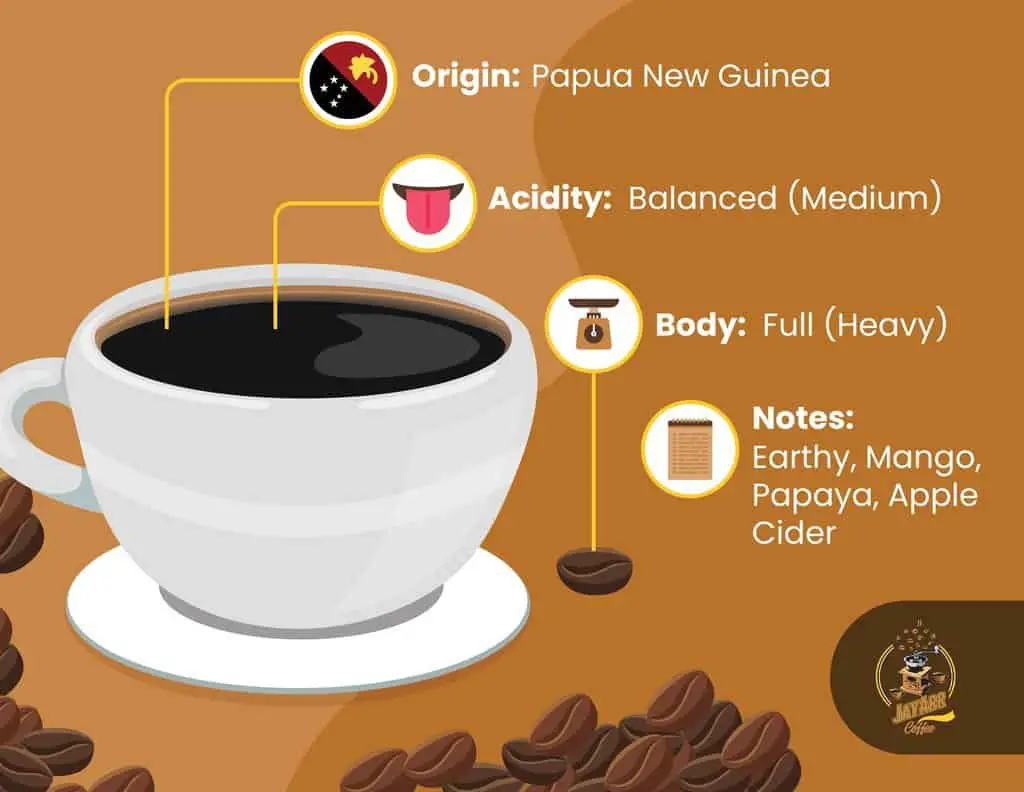
Papua New Guinea coffee frequently combines sweet tangs with low-toned fruity richness, medium acidity, a heavy body and an earthy flavor. It offers a bright-clean finish with a zesty, fruity aroma. Particular notes of Papua New Guinea single origin coffee commonly include mango and papaya. Coffees produced in Papua New Guinea are often known to be oilier than other coffees and which is particularly pronounced in medium roasts. Consequently, Papua New Guinea coffee is particularly great when using a steel-filter drip or a French press, to preserve the rich texture and flavor these oils offer.
Coffee Production Areas in Papua New Guinea
The mountain highlands of Papua New Guinea are the principal areas where most of the traded coffees are grown. You would also find premium quality coffee beans grown in the central Highlands of Mt. Hagen- a fertile land, rich in volcanic soil, with perfect weather conditions for growing coffee plants.
From the time when coffee production was spread out to local small-scale farmers in the 80s, most of Papua New Guinea coffees have been cultivated on small plantations.
Types of Arabica Coffee Beans Grown in Papua New Guinea
Papua New Guinea offers a wide array of fruity-flavored Arabica varieties including:
- Hybrid Mundo Novo
- Caturra
- Catimor
The high-quality Arusha coffee is grown in the mountainous highlands of Papua New Guinea. This particular coffee can be of two different arabica varieties: the French Mission or the Typica.
High-quality coffee in the area includes;
- New Guinea Kimel Coffee
- New Guinea Arona coffee
New Guinea Kimel Coffee
This particular coffee is renowned for its natural and chocolatey tangs. It is a full-bodied coffee with medium-bright acidity, rounded off with a wild herbal undertone, making it one of the most remarkable coffee varieties in the region. In some ways, the smell and the flavor profile of the New Guinea Kimel coffee is similar to the renowned Jamaican Blue Mountain and has a heavy body similar to Indonesian coffees like Sulawesi Toraja.
New Guinea Kimel Coffee is prolifically cultivated in the eastern highlands of Papua New Guinea. If you are a coffee enthusiast looking for high-quality coffee flavors, ask for the medium-dark or medium–brown New Guinea Kimel Coffee.
New Guinea Arona Coffee
New Guinea Arona coffee offers a well-balanced aroma with fruity notes and rich tangs. Its exotic taste draws comparison to both Sulawesi Toraja and Sumatran coffee. However, it is not as aromatic as the latter nor as full-bodied as the former. Like most New Guinea coffees, it is cultivated in the mountainous highlands and is wet-processed. Since it offers balanced acidity, New Guinea Arona remains a “go-to” coffee variety in Papua New Guinea and is ideal for your everyday cup of coffee.
Nicaraguan Single Origin Coffee
History
High-quality coffee beans are the principal trade of the Nicaraguan economy. Nicaragua is the 12th largest coffee-producing country on the plant, and it has been one of the largest producers in the world for more than a century, starting in the 1850s.
However, ever since the Nicaraguans began the large-scale cultivation and exportation of coffee in the 1800s, they have experienced setbacks, including civil war, hurricanes, and a prior U.S. embargo on the importation of all Nicaraguan coffees. Nonetheless, Nicaragua has managed to successfully navigate these challenges and remains a world leader in the production of high quality coffee.
Tasting Notes of Nicaraguan Coffee
Nicaraguan Coffee has a distinctive taste with flavors like vanilla and various nuts, delivered in a balanced body and a fruity, low acidic profile. Additionally, high-grade Nicaraguan coffee often leans towards higher tone characteristics, like floral and citrus notes (as opposed to low toned flavors like apricot, chocolate, and papaya).
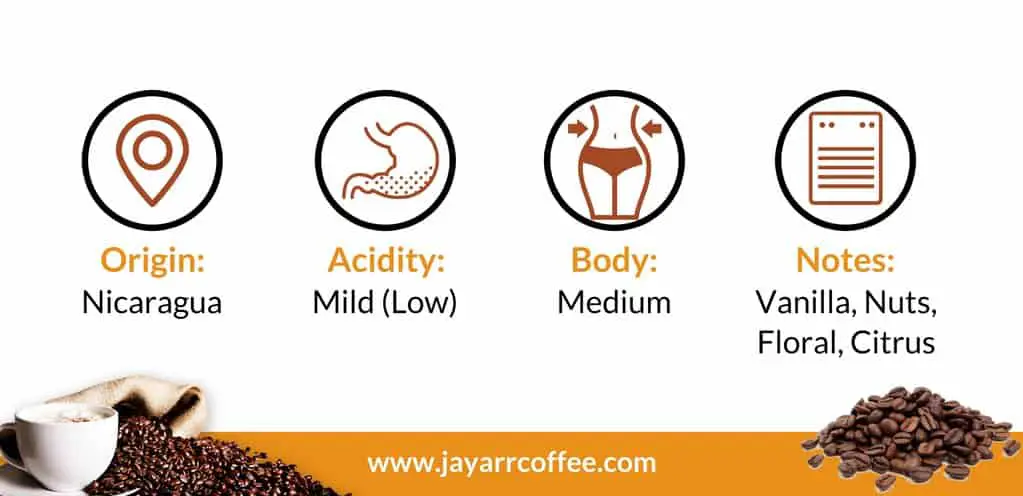
Nicaraguan coffee shares many similarities with other origins of coffee grown in Central America. However, Nicaraguan coffee is less acidic. While most of the countries in the Central Americas have low growing elevations, Nicaragua growing areas are at higher elevations. The determining factor for the premium quality of the Nicaraguan coffee is the growing elevation or altitude. Nicaragua SHGs (Strictly High Grown) is known as the highest quality coffee produced in Nicaragua. Nicaragua SHG may contain more acidity than other varieties of Nicaraguan Single Origin coffee.
Types of Arabica Coffee Beans Grown in Nicaragua
Bourbon is the most prominent coffee variety cultivated in Nicaragua and its top notes include pie crust, chocolate, pear, and vanilla. There are other coffee varieties in the area, such as Pacamara, Aturra, Maragogype, Maracaturra, Ctimor, and Yellow & Red Catuai.
The Nicaraguan Coffee Trade
Nicaragua shares a border with Honduras and Costa Rica and exports a wide range of premium quality coffee to these areas and beyond. Coffee cultivation and exportation is a principal source of revenue for the country and Nicaragua is home to some of the most renowned coffee producing regions on the planet, including Segovia, Matagalpa, and Jinotega. Other prominent market names in Nicaragua include Madriz, Esteli, and Granada/Mangua.
When exporting Nicaraguan coffee out of Central America to the US and beyond, green coffee shippers source unroasted coffee beans from local partners (distributors or brokers) and ship them out of Nicaragua in container-quantities (About 45,000 pounds of coffee beans). After shipping, the coffee beans are packaged into 132-pound coffee bags for easy distribution across the country. These 132-pound bags are sold to local coffee companies at wholesale prices, where they are processed or blended as refined coffee.
Areas in Nicaragua where Coffee is Cultivated
Nicaragua is a high-volume manufacturer of sweet-acidic coffee beans, with lots of coffee varieties grown in different regions across the country. Due to the different regions in Nicaragua where coffees are grown for export, there are also different levels of coffee quality across the country. However, if you know the part of Nicaragua where your coffee beans are sourced, you’ll be able to ascertain the purity and quality of your Nicaraguan coffee. Here are some of the popular market names and regions in Nicaragua.
Matagalpa Region
The Matagalpa region got its name from the capital city of Matagalpa and encompasses a wide array of coffee cooperatives and estates. The primary coffee varieties grown in this region are the Bourbon and Caturra varieties, and they usually grow within the 1000 – 1400 meters’ range.
Jinotega Region
The Jinotega region is one of the most highly-respected and prolific cultivators of Arabica in Nicaragua. The coffees produced in this area are renowned for their top-notch quality and their characteristic mild sweet and acidic tones. The coffees produced in this area, grow between the 1100 – 1700 meters’ range.
Segovia Region
Coffee from the Segovia region offers a fruity overtone (an almond-nougat syrupiness), highlighted by rich chocolate flavor. It is very scarce in the Nicaraguan coffee market and it grows between the 1000 – 1400 meters’ range. The region features a plethora of high-quality bourbon and Caturra beans.
India Single Origin Coffee
The land of king cobras, elephants, and Mahatma Gandhi- India. However, you might not know that India produces a number of high quality single origin coffees. As one of the largest suppliers of coffee in the globe and a rapidly growing force in the specialty coffee market, it’s worth learning about- and paying attention to- Indian coffee.
History of Coffee in India – A Centuries-Old Way of Life
How did coffee get to India in the first place? Well, the answer to this question is the stuff of legends – straight from a Tom Clancy novel.
You may know that coffee was first cultivated in Ethiopia- the story of a herder and his caffeine-induced goats via eating coffee cherries. Since then, the crop rapidly spread throughout the world, including to the Ottoman Empire during the 1600s. Unfortunately, Turks roasted or boiled every coffee bean in sight before leaving the port of Mocha in Yemen as a selfish attempt to prevent the cultivation of the “magical brew” in other regions. Well, that was until Saint Baba Budun pulled off one of the most significant heists in Indian history.
Around 1670 AD, St. Baba Budan smuggled 7 beautiful coffee cherries from Yemen to India on his way back from a pilgrimage in Mecca (quite the saint, huh?). Some even say that he taped the seeds to his belly, while others claim that it was his beard. Whichever ingenious tactic he used, the saint proceeded to plant the cherries somewhere in Chikmagalur, Karnataka. A few hills in the region are known as “Baba Budan Giris” in honor of the legend himself.
Later in the 18th century, British entrepreneurs relentlessly led an initiative to set up coffee plantations in South India. Despite the country’s rich coffee history, the crop did not fully meet its potential until the 1990s when individual farmers took control of the crop sales from the government. This move led to the production of higher quality coffee. Much like its economy, India’s coffee industry is rapidly evolving into a force to be reckoned with – it’s quickly earning a rosy reputation in gourmet coffee circles.
Indian Coffee Growing Regions and Climate
Part of why Indian single-origin coffee is causing waves in the coffee industry is due to the cultivation conditions in the Asian country. India’s Coffee growing regions can be divided into two main categories. The first category representing traditional growing regions in the Southern states of Tamil Nadu, Kerala, and Karnataka and the other category including the non-traditional areas of East and North Eastern Ghats. According to the Coffee Board of India, Indian coffee in the East Ghats region is typically grown in ecologically sensitive regions under the canopy of natural shades. This non-traditional area is recognized as a global biodiversity hotspot, with a canopy shade comprising of over 50 types of shade trees. The evergreen leguminous trees of the area host diverse fauna and flora, protect the coffee plant from temperature fluctuations, enrich the soils, and prevent erosion in the sloping plantation terrain.
With numerous regions having altitude of roughly 3,700 feet, soils rich in essential minerals, and cool temperature, India is an ideal location to produce premium coffee – provided that the right cultivation and processing conditions are met. However, it is worth noting that coffee growing regions in India have diverse climates, leading to cultivation of different varieties with different taste notes. India’s warm and humid regions are well-suited for Robustas, while its high elevations are best for Arabicas.
Notable Indian Coffee Beans
Unlike other single-origin countries such as Colombia that only cultivate Arabica beans, India grows both the Robusta and Arabica species – talk about versatile farming. However, the simmering cup of Indian coffee in your hands is most likely to be either Kents, S.795, Cauvery, or Sln.9. The latter variety was actually crowned as the best Indian Arabica in the 2002 ‘Flavor of India – Cupping Competition’ hosted by the Coffee Board of India. Now to Indian single origin gourmet coffees.
Generally, there are 3 specialty coffees from India that have garnered considerable attention among connoisseurs, baristas, and coffee experts. And just like the origin of coffee in India, each of these coffees has a story to tell:
- Monsooned Malabar AA: A long time ago in a sailing ship transporting coffee beans to Europe, one of the best accidents in the coffee industry happened– the “monsooning effect.” Moisture in the monsoon winds was absorbed by the en-route coffee beans, resulting in an intense mellow flavor and a change in color. The unique character of these monsooned coffee beans won the hearts of connoisseurs, and the rest is history. Today, monsooned coffee is prepared in the West Coast of Southern India at curing stations. The Arabica or Robusta beans are stored in warehouses, where monsoon winds are allowed to circulate and do their magic. The Monsooned Malabar AA is arguably the best quality monsooned coffee from India.
- Robusta Kaapi Royale: This specialty coffee from the regions of Travancore, Chikmagalur, Wayanad, and Coorg, is known as the king of Robusta ‘kaapis.’ It is often depicted by the symbol of an elephant and a canopied seat – signifying Indian royalty. The coffee is prepared from the best Robusta coffees available. These beans are characterized by grey-blue color and pointed ends. Robusta Kaapi Royale coffee has a full body, mellow, smooth, and soft flavor.
- Mysore Nuggets Extra Bold: If you are seeking rare and premium single-origin options, then Mysore Nuggets Extra Bold should be at the top of your to-drink list. These exotic and enticing washed Arabica coffees are cultivated in the regions of Shevaroys, Bababudangiris, Biligiris, Coorg, and Chikmagalur. The beans are rather large with a polished appearance and blue-green color. They have a delicate flavor, medium body, good acidity, and hints of spice – a connoisseur’s delight.
Characteristics of Single-Origin Coffee from India – Tasting Notes
Good Indian coffee has similar flavor profiles and tasting notes to Indonesian coffees. The coffees tend to have a pronounced body with mild acidity and hints of subtle earthiness or spice. While sipping a morning cup of Indian single-origin coffee, you might identify spicy flavors such as nutmeg, pepper, clove, cardamom, or even hints of tropical fruits. But as stated earlier, there are numerous coffee-growing regions with different cultivation conditions – not to mention a wide range of different arabica varieties grown in India.
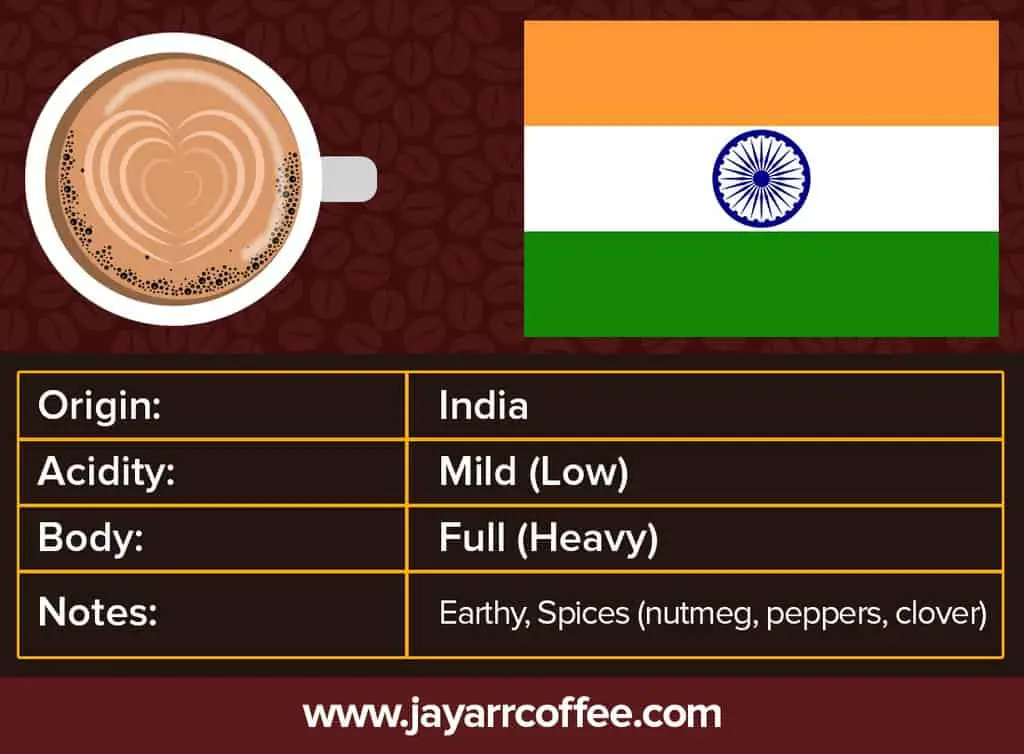
If you want to really taste India in your cup, we highly recommend the famed monsooned coffee. These beans have the syrupy flatness of aged coffee, reduced acidity, and a musty flavor – perfect for those of us who love strong coffee with earthy notes. The weakened acidity of monsooned coffee beans makes them an ideal choice for espresso blends.
Final Verdict
Indian coffee has an extraordinary historical origin and flavor. From a saint smuggling coffee beans from Yemen 400 years ago to a lucky accident at sea, the country seems to be destined to produce coffee.
Single-origin coffees from India are arguably one of the best shade-grown coffees in the industry. They offer a stimulating intensity and intriguing subtlety that is unique to the cultivation conditions in the country. With the rising status of Indian coffee among connoisseurs, it is interesting to see what the future holds. But in the meantime, you can sample the Mysore Nuggets, Robusta Kaapi Royale, Monsoon Malabar, Bababudan Giris, or Monkey Parchment Coffee for a superb cup of Indian single origin coffee.
Colombia Single Origin Coffee

(By Diego Delso, CC BY-SA 4.0, https://commons.wikimedia.org/w/index.php?curid=42315380)
What comes to mind when you think of Colombian coffee? Some of you might picture a coffee farmer with a killer mustache and a trusted mule by his side – that guy is Juan Valdez. Colombia is stereotypically associated with coffee, and for a good reason! For Colombia, coffee is more than a refreshing brew to kick-start a day; it is a key part of its identity and culture. The South American country is one of the leading producers of high-end Arabica coffee. It is estimated that Colombian production accounts for 12% of all coffee in the industry. UNESCO even recognized the country as a World Heritage Site since it’s “an exceptional example of a sustainable and productive cultural landscape.”
But what makes the nation a coffee powerhouse? Why is coffee from Colombia (single-origin) so famous and revered? Does Colombian single-origin coffee have distinct notes? Read on for in-depth analysis and explanation of what makes Colombian coffee so unique. Knowing more about the origin of your favorite cup of coffee might help you appreciate the enticing flavor and aroma you crave every morning.
Where it All Began – The History of Coffee in Colombia
How did Colombia come to be the coffee production titan it is today? It’s believed that Jesuit priests brought coffee to Colombia in the 18th century. Approximately 30 years later, Colombia exported the first coffee beans to the United States. By just before the 19th century, over 170,000 bags had been shipped to the U.S. alone.
As the coffee industry grew, so did the need for proper regulation. The Colombian government realized that the coffee industry had economic potential and was a vital part of Colombia’s national identity. With this in mind, the Federación Nacional de Cafeteros de Colombia (FNC) was formed in 1927 to represent coffee growers and help grow coffee in an integrated way.
As we noted earlier, the most recognizable aspect of Colombian coffee for most people is probably Juan Valdez. Even appearing in the movie Bruce Almighty, Juan Valdez was created in 1950 by the FNC as part of an incredibly successful marketing campaign to promote Colombian coffee. This marketing effort coincided with Colombian coffee exports continuing to grow over the next 50 years.
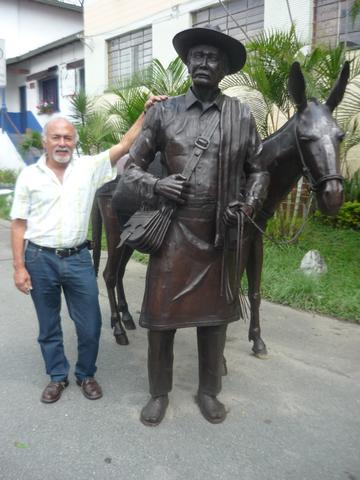
(By Yimicorrea – Own work, CC BY-SA 3.0, https://commons.wikimedia.org/w/index.php?curid=35811019)
Fast-forward to the 21st century and the Colombian government’s focus is on ensuring the coffee industry has a positive social and economic impact. Coffee farming is the nation’s largest source of employment for rural families. Additionally, Colombia is currently the third largest coffee producer, surpassed only by Vietnam and Brazil. This impressive status is attributed to the unique cultivation conditions in Colombia.
What Makes Colombia Unique for Coffee Growing? – The Cultivation Conditions
Did you know that Colombia grows only Arabica coffee? Maybe this is because Colombia has perfect conditions for growing premium arabica. But to understand what is so special about the country, it’s important to learn what the ideal cultivation conditions for arabica plants are.
Although the coffee plant has many species, Coffea canephora (Robusta) and Coffea arabica are the most common – the latter accounting for nearly 85% of global coffee. Arabica coffee is widely regarded as the superior species due to its refined bean, which is a favorite among coffee connoisseurs for its complex and delicate brew. It’s therefore not a surprise that the most expensive specialty coffees in the market are almost always arabica. But arabica, versus the more hearty robusta, is particularly fussy about growing conditions.
Arabica plants thrive in a relatively small temperature range of 17° to 23° Celsius (62-75° Fahrenheit), and with 1,200mm to 2,200mm of yearly rainfall. Arabica also prefers altitudes between 1,340 meters to 2,130 meters (4,400-7,000 feet) and both the taste and the quality of the coffee beans generally improve with increasing elevation. The region must also be free of frost, and preferably at a latitude of between 30ºS and 30ºN (aka The Coffee Belt/Coffee Zone).
Coincidentally, Colombia has the ideal geographic conditions to grow arabica coffee. The high elevation, wet climate, decent infrastructure, and nutrient-rich volcanic soil make the country well-suited for coffee production. Although there are several regions in Colombia that grow coffee, the main areas are:
- The Coffee-Growing Axis/Belt: This area, located in the vast central region, includes departments such as Risaralda, Quindío, and Caldas. It is the heartland of Colombian coffee, covering more than 14,000 square kilometers.
- Mountainous Regions: This region is located near the equator where farmers can grow the plants at high altitudes. This leads to a slower ripening process, but better flavor. Although the yield from this region is low, it also produces the most sought-after Colombian coffee beans.
Other key points to note regarding Colombian cultivation conditions are the harvest periods and the quality of the coffee. Colombia has two harvest seasons – March to June, and September to December. Regarding export quality, you’ll likely hear the terms Supremo or Excelso thrown around. Supremo is regarded as the better grade partly due to the larger coffee bean in comparison to the Excelso grade.
Colombia Single-Origin – Arabica varieties and Brands
Are you part of the single-origin movement? Well, an increasing number of coffee lovers are- including us! In a noble attempt to achieve a better and consistent coffee experience, people are increasingly seeking coffee beans from select regions/countries with a reputation for pronounced flavor notes. And one such country is Colombia.
As we will discuss later, single-origin coffees from Colombia have different flavor profiles and notes, despite the fact that they all come from arabica. The arabica varieties that are cultivated in Colombia include Typica, Caturra, Bourbon, Maragogype, Castillo, and the Colombian cultivar. The coffees grown in Colombia are often named after their farming regions. For example, coffees from the main growing axis are marketed as MAM – an acronym for Manizales, Armenia, and Medellin cities. Some reputable and high-quality Colombian single-origin coffees are:
- Colombian Peaberry
- Colombia Supremo
- Colombian Huila Coffee
- Colombian Medellin
Notes and Flavor Profile of Colombian Coffee
There are around 20 departments within the country that produce coffee– each having a distinct flavor:
- Southern Departments: The high elevation in regions such as Huila, Cauca, and Nariño produces coffee with complex flavor profiles, floral aromas, and higher acidity.
- Central Departments: Along the “coffee belt” in departments such as Quindío, Caldas, and Antioquia, coffees are well-rounded with mellow acidity, a gentle sweetness, and nutty/chocolate flavors.
- Northern Departments: Higher temperatures and lower altitudes in Santander, Santa Marta, and other northern regions produce coffees with deep flavor notes and a full body.
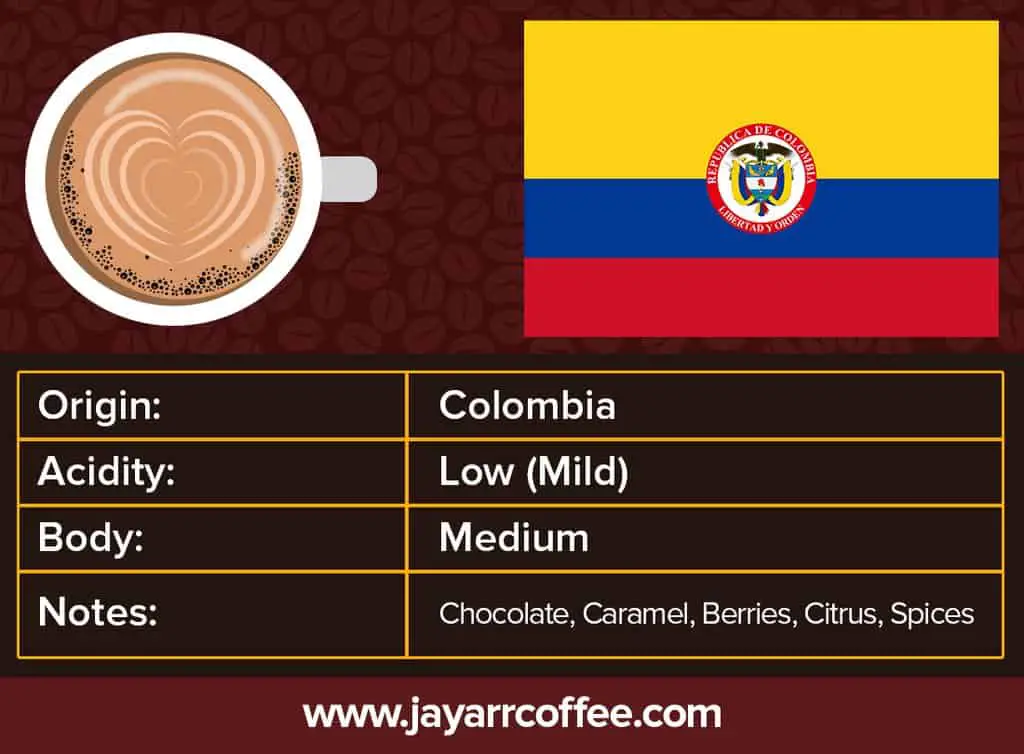
Although it is difficult to point out a definitive set of taste notes that are characteristic of Colombian coffee, there are a few recurring features. For example, Colombian coffees are known to have a smooth, mild, vibrant, and easy-drinking flavor. They are also low in acidity with a medium/balanced body and notes of chocolate and caramel. The aromas tend to be fruity or citrusy, with hints of spice. Additionally, processing stations utilized the washed method, leading to a high flavor clarity and a pleasant sweetness.
Tips on Brewing and Roasting
The beauty of Colombian coffee generally is its versatility in taking well to different roasts. Medium or dark roasts lead to a rich aroma with intense flavors. The acidity is muted by the sweeter cocoa flavors and bright fruitiness. If you decide to go with light roasts, expect to highlight the citrus fruit undertones and bright acidity. The flavor of the bean is maintained, but with hints of caramel and cocoa.
Which is the best way to brew Colombian single-origin coffee? Well, the answer largely depends on the origin and roast of the beans. As a go-to for coffee drinkers world wide, Colombian coffees work great in a traditional drip brewer. Alternatively, Colombian coffee works great in an AeroPress as it allows for experiencing the full-bodied mouthfeel. There is an annual AeroPress Championship hosted in Colombia’s capital, Bogota.
Indonesian Single Origin Coffee

While today Indonesia is the fourth-largest producer of coffee in the world, few realize that it was also one of the first countries to start growing coffee commercially. Arabica coffee plants were first imported into Indonesia in the 17th century during the Dutch East India Company’s occupation, with the aim of destabilizing the Arab monopoly on the coffee market.
Despite its introduction under colonialism, coffee quickly became an integral part of the Indonesian culture and economy and, today, over 90% of the coffee is still produced on smallholdings, often less than three acres in size. Due to its overall high production and unique specialty offerings, Indonesia remains center-stage in the world coffee trade.
What varieties of single origin Indonesian coffee are there?
As with other single origin coffees, Indonesia offers a number of different varieties, each with a different flavor profile. Some of these varieties are:
- Sumatra (one of the most popular Indonesian coffees in the US)
- Java (another world-famous Indonesian coffee)
- Toraja
- Flores
- Papua
- Aceh
- Lintong
- Gayo
- Mandheling
What regions of Indonesia is coffee grown in?
There are three main regions of Indonesia where coffee is produced: Java, Sumatra, and Sulawesi.
Java island is one of t1he largest producers of coffee and is renowned for its production of high-quality arabica beans. The arabica beans on Java are usually processed using a wet method. Java coffee is typically harvested from June through October.
Sumatra produces some of the world’s most favorite and famous coffees, Mandheling and Aceh. Beans on this island are harvested from November through March and have the earliest harvest season in Indonesia because of this northwestern-most island’s proximity to the equator.
Sulawesi (once known as Celebes) is a large island with many different regions producing coffee. Coffee grown here is largely processed using a dry method. The most famous coffee-growing region on Sulawesi is Toraja, a mountainous area where robusta coffee plants grow 4900ft above sea level. Other regions in Sulawesi that grow robusta coffee plants are Bengkulu and Lampung. Arabica plants are grown in South Sulawesi. The harvest season in Sulawesi is from May through November.
Two other regions that produce coffee are Bali and Flores.
Bali, also a popular vacation destination, produces Kintamani coffee. Kintamani coffee is produced in the Kintamani Highlands between the Batukaru and Agung volcanoes, so the soil is extremely fertile and perfect for growing great coffee. Harvest season in Bali is typically between May and October.
Flores was named for its beautiful foliage by the Portuguese who discovered the island. It is one of the most recent areas to start growing specialty coffee, but it has quickly become popular for its great taste. Coffee in Flores is harvested from May through October.
What types of arabica beans are grown in Indonesia?
There are approximately 933 hectares of robusta plantations in Indonesia, significantly more than the 307 hectares of arabica plantations.
Varieties of arabica bean coffee are:
- Aceh
- Java
- Arusha
- Bergendal
- Sidikalang
- Toraja
- Kalossi
- Mandheling
- Lintong
- Timor
- Typica
What coffee notes do Indonesian coffees usually have?
Indonesian coffees often have a strong, robust flavor with mild acidity and a heavy body. Generally, Indonesian coffees offer an earthy taste with notes of spice and sweetness as well as wood, tobacco, and leather.
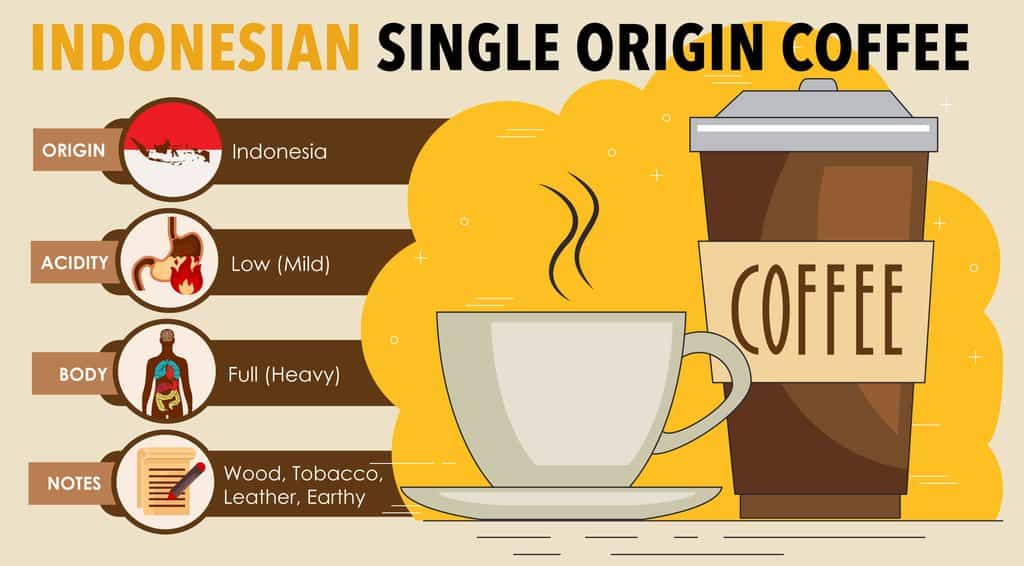
Here are some of the most popular varieties and the notes associated with them:
- Sumatra: a high-bodied coffee with earthy notes.
- Java: a light-bodied coffee with a nutty flavor, with notes of chocolate and herbs.
- Toraja: a medium-bodied coffee with notes of coffee, caramel, and herbs.
- Flores: a medium-bodied coffee with notes of citrus.
- Papua: a medium-bodied coffee with fruity notes.
- Aceh: a high-bodied coffee with earthy notes.
- Mandheling: a high-bodied coffee with tobacco notes.
- Bali: a light-bodied coffee with a nutty flavor and orange undertone.
Conclusion
Single-origin coffee, regardless of where it is grown, will provide the coffee-drinker a unique coffee drinking experience. We highly recommend sampling single-origin coffees from each of the regions we describe above in order to discover your favorites.
Check out our supplement- 4 additional origins- here!
